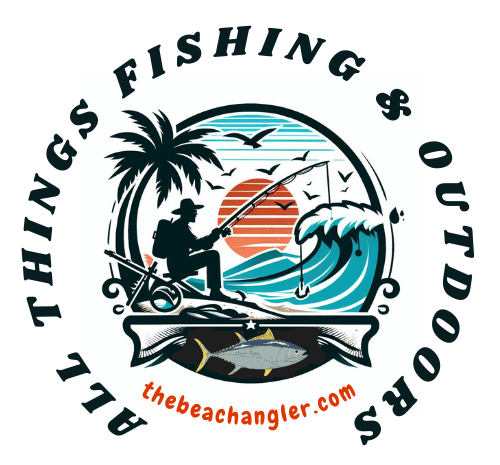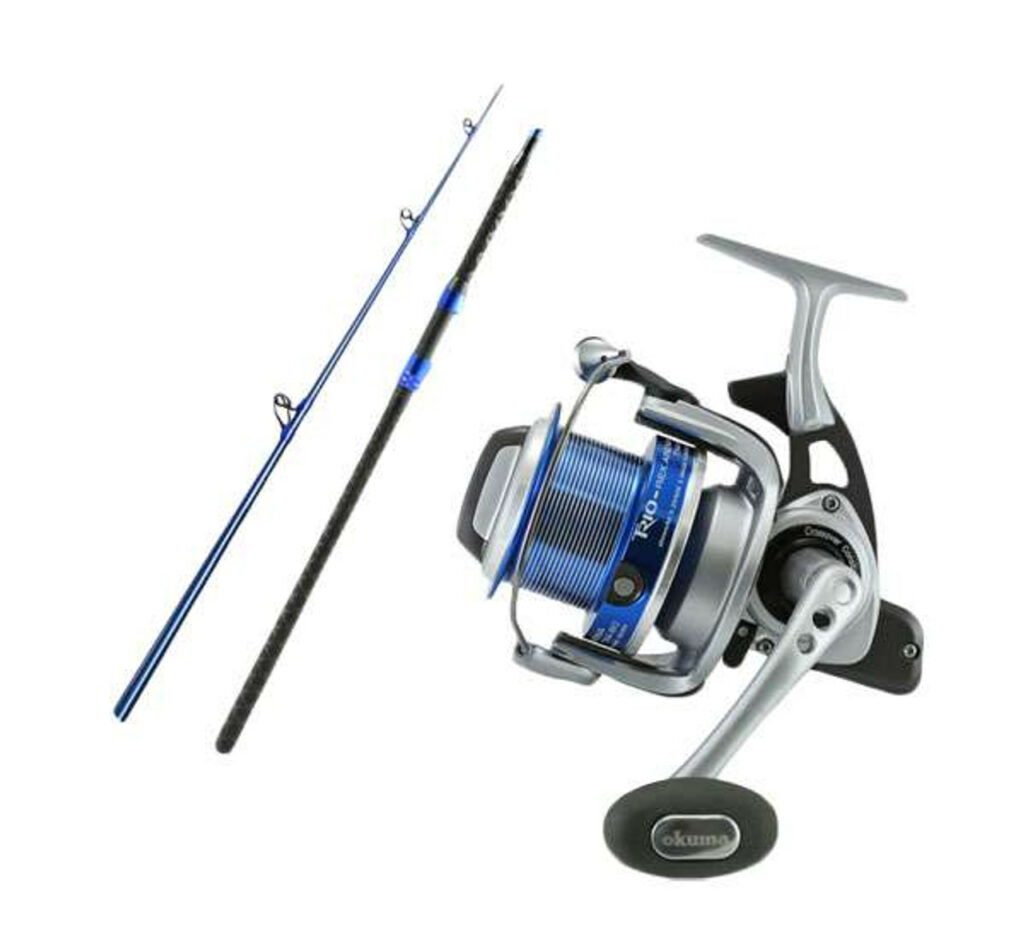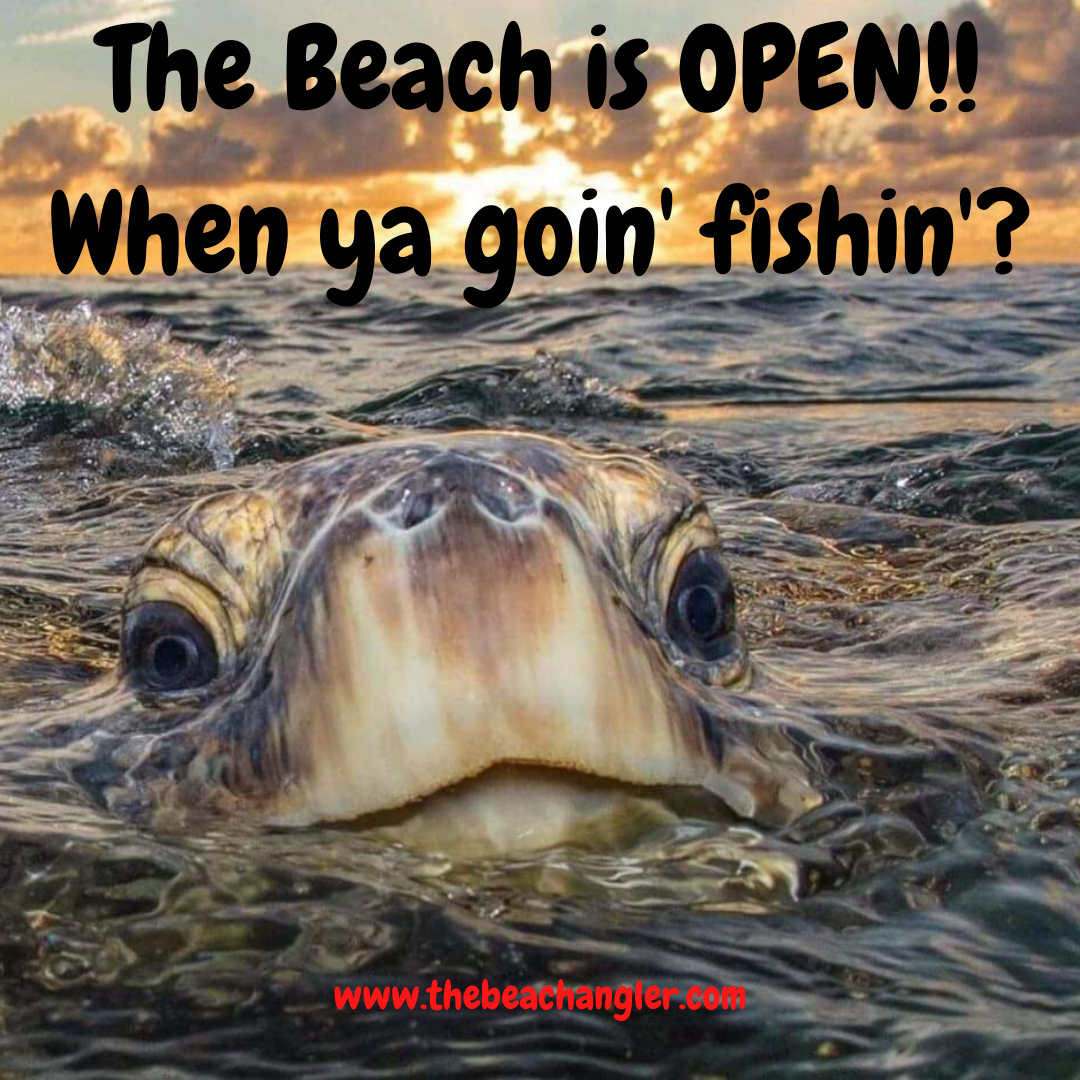Ahoy, fellow anglers! If you’re itching for an adrenaline-pumping fishing experience, look no further than learning how to catch tarpon from the beach. These magnificent silver kings are the stuff of surf angler’s dreams – powerful, acrobatic, and downright elusive. But fear not! In this guide, we’ll spill the secrets on how to tackle this challenging pursuit and hook some leaping leviathans from the sandy shores.
In my half century of surf fishing, I have watched schools of tarpon and king mackerel cruising the beachfront busting schools of mullet on their annual migration. Watched helplessly as a hooked tarpon jumps out of the water, throws the hook, and swims away. Finding and hooking a tarpon are one thing, actually landing the silver king is another matter altogether.
QUICK LOOK:
5 Tips for Catching Tarpon From the Beach
- Study the Tides. Tarpon have a thing for tidal movements, especially during incoming and outgoing tides.
- Keep an Eye on the surface. Tarpon are sun seekers. They love to bask near the surface in sunny conditions, making them easier to spot.
- Locate baitfish schools, cast in their direction, and wait. Find the bait, find the tarpon.
- Tarpon are most abundant in the Gulf of Mexico, Florida, and the West Indies. So these are the best places to catch tarpon from the beach.
- Tarpon migrate up rivers to feed so if you want to surf fish for tarpon, look for beaches that are near freshwater streams.
Known as the silver king, because of their shiny scales and majestic appearance. Tarpon are large fish that can put up a fight like no other and can be caught on a variety of baits and lures from the beach. So, If you are looking for a thrilling and arm straining fishing experience, you might want to try beach fishing for tarpon. Follow along and we will give you some tips and tricks on not only, how to catch tarpon from the beach, but information on their habits, behavior, and biology as well.
What are Tarpon?
Tarpon are fish of the genus Megalops. They are the only members of the family Megalopidae. And, they belong to the order Elopiformes, which also includes bonefish and ladyfish. The two species of tarpon are M. atlanticus (Atlantic tarpon) and M. cyprinoides (Indo-Pacific tarpon). M. atlanticus is found on the western Atlantic coast from Virginia to Brazil, throughout the Caribbean and the coast of the Gulf of Mexico.
Tarpon are also found along the eastern Atlantic coast from Senegal to South Angola. M. cyprinoides is found along the eastern African coast, throughout Southeast Asia, Japan, Tahiti, and Australia. Both species are found in marine and freshwater habitats, usually ascending rivers to access freshwater marshes.

They are able to survive in brackish water, waters of varying pH, and habitats with low dissolved O2 content due to their swim bladders, which they use primarily to breathe. Tarpon can also rise to the surface and take gulps of air, giving them a short burst of energy.
Tarpon can grow up to 8 feet long and weigh up to 280 pounds, making them one of the largest and heaviest fish that can be caught from the shore. They have a distinctive appearance, with a large mouth, a forked tail, and large scales that reflect light. They are also known for their incredible jumping ability. Tarpon can leap up to 10 feet out of the water when hooked, often shaking their heads violently to try to throw off the hook.

This makes them very challenging and exciting to catch, but also very difficult to land. Tarpon have a very hard mouth that can easily break or bend hooks, so you need to use strong and sharp hooks to secure them. They also have a special organ called a swim bladder, which allows them to breathe air at the surface.
This gives them an advantage over other fish in low-oxygen waters, but also makes them more vulnerable to anglers who can spot them when they come up for air. Adult tarpon diet includes small fish, like sardines and anchovies. They also scavenge for dead fish and eat larger crustaceans, such as crabs and shrimp.
Why Fish for Tarpon from the Beach?
With fish up to eight feet long and weighing as much as 280 pounds, tarpon are a truly giant fish. And, despite their size, tarpon are incredibly acrobatic especially when hooked which makes landing them even harder than getting one to eat. Much like surf fishing for Snook, fishing for tarpon from the beach has many advantages over fishing for them from a boat or a pier.
First of all, it is more accessible and affordable. You don’t need a boat, or a guide to fish for tarpon from the beach. You just need a rod, a reel, some line, some hooks, and some bait. You can fish for tarpon from any beach that has access to deep water and strong currents, where tarpon like to feed and migrate. You can also enjoy the scenery and the atmosphere of the beach while fishing for tarpon.
Secondly, fishing for tarpon from the beach is more challenging and rewarding. You have to deal with waves, wind, sand, and other obstacles that can affect your casting and retrieving. You also have to fight the tarpon on foot, without the help of a boat or a net.
Use your skills, strength, and stamina to land the fish on the shore. This can take anywhere from 15 minutes to an hour or more, depending on the size and mood of the fish. When you finally land a tarpon on the beach, you will feel a sense of accomplishment and satisfaction that is hard to beat, and an accomplishment few anglers ever experience.
How to Catch Tarpon from the Beach: Preparing for the Battle
Fishing for tarpon from the beach requires some preparation and planning. Here are five key steps that you should follow:
1) Choose the right time and place. Tarpon are most active during the early morning and late evening hours, low-light conditions, and during tidal changes when they feed on baitfish near the shore. They also tend to migrate along the coast during certain seasons, depending on the water temperature and salinity.
For example, in Florida, tarpon migrate northward in spring and southward in fall, but the peak time to target them is in May and June. During these peak months, it’s common to see hundreds, if not thousands, of fish off Florida’s gulf coast beaches.
2) Choose the right gear. You will need a heavy-duty rod and reel that can handle large fish and long fights. A 10-12 foot surf rod with a spinning or conventional reel is ideal for beach fishing for tarpon. You will also need a strong braided line (50-80 pound test) that can resist abrasion from sand and rocks.
For hooks, you should use circle hooks (size 6/0-10/0) that can penetrate the hard mouth of tarpon without harming them too much. Tarpon can be picky, so presenting your bait convincingly is crucial. A simple and effective rig involves a fish finder or knocker rig. Pair it with a fluorocarbon leader to reduce visibility.
For bait, you can use live or dead baitfish (such as mullet, pinfish, crabs, shrimp, or sardines) that match the natural prey of tarpon. Stake out above areas that hold tarpon and drift your live bait down to the fish. Hook crabs in the corner of the shell and baitfish through the mouth. The best bait for tarpon doesn’t spin in current, so pinch off the heads of shrimp.
Tarpon will also take a variety of lures when they are actively feeding. Big spoons, topwaters, swim baits and soft plastics will all catch tarpon. Favorite colors are natural color combinations like a silver body with a black back, but glow and white colored artificials work very well too.
3) Choose the right spot. Look for areas where there is deep water close to the shore, such as sandbars, troughs, channels, or cuts. These are places where tarpon like to swim and hunt for food. Look for signs of tarpon activity, such as rolling (when they come up for air), splashing (when they chase baitfish), or boiling (when they feed in groups). Cast your bait as close as possible to these areas, and let it drift with the current.
4) Choose the right technique. Use a simple and effective technique to fish for tarpon from the beach. Cast your bait as far as you can, and let it sink to the bottom then reel in the slack line, and wait for a bite. Don’t set the hook immediately when you feel a bite, but wait for the tarpon to swallow the bait and turn away then tighten the line, and let the circle hook do its work.
Then fight the tarpon with patience and skill, keeping the line tight and avoiding slack. Avoid lifting the rod too high, as this can cause the hook to pull out or break. Let the tarpon run and jump, and bow to the king when the fish jumps to avoid break offs. Try to steer the fish away from obstacles and other anglers and keep the tarpon in shallow water, where it is easier to land.
5) Choose the right way to land and release the tarpon. Never drag a tarpon on the sand, as this can damage its scales and skin. Never lift a tarpon by its gills or eyes, as this can injure or kill it. Use a wet towel or a glove to grab the tarpon by its lower jaw, and support its weight with your other hand under its belly.
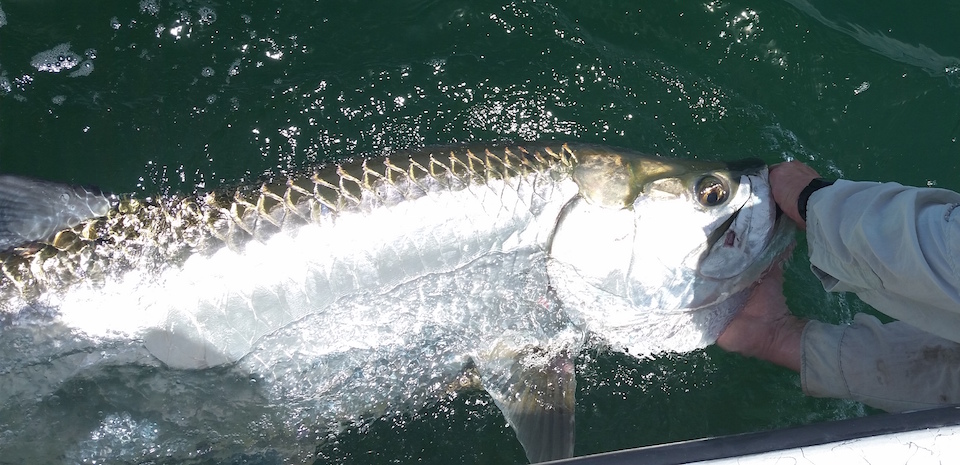
Remove the hook carefully, using pliers or a dehooker then take a quick photo or measure the tarpon, if you wish, and release it as soon as possible. However, before you release it, revive the tarpon by holding it in the water and moving it back and forth until it swims away.
Tips and Tactics on How to Catch Tarpon from the Beach
Locating the Silver Kings:
- Study the Tides. Tarpon have a thing for tidal movements, especially during incoming and outgoing tides. Plan your fishing sessions around these tides to increase your chances of encountering a school of hungry tarpon.
- Keep an Eye on the surface. Tarpon are sun seekers. They love to bask near the surface in sunny conditions, making them easier to spot. So, keep those sunglasses on and scan the waters for those shimmering backs!
- Locate baitfish schools, cast in their direction, and wait. Tarpon and other toothy critters like king mackerel, will be following the schools looking for an easy meal. Find the bait, find the tarpon.
- Tarpon are most abundant in the Gulf of Mexico, Florida, and the West Indies. So these are the best places to catch tarpon from the beach. They are also found in the southeast regions, but in much smaller quantities.
- Tarpon migrate up rivers to feed so if you want to surf fish for tarpon, look for beaches that are near freshwater streams. A good casting distance will help you get more bites. Sometimes, you will need to aim for the second or third sandbar to draw a strike from a tarpon.
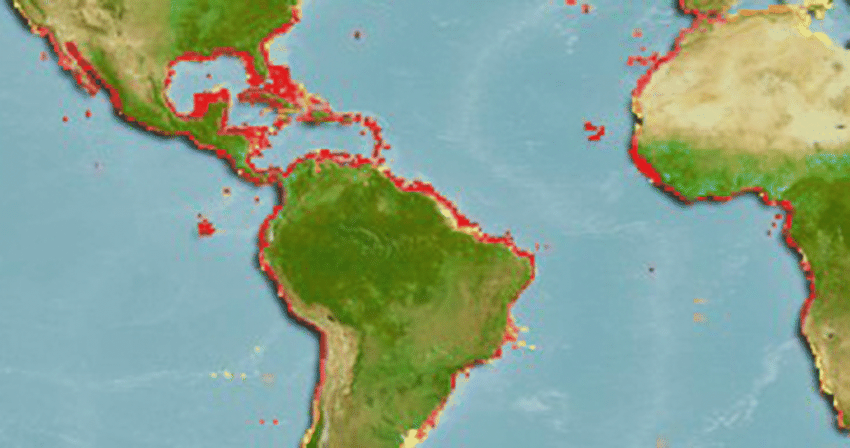
The Battle Royale: Bow to the Silver King
Brace for the Jump Once hooked, tarpon will put on an aerial show that rivals Cirque du Soleil. Brace yourself for their jaw-dropping jumps, and keep your rod low to absorb the shock. Bow to the Silver King When the tarpon takes off on a blistering run, bow to their majesty by lowering your rod tip. This reduces the tension on the line, preventing it from snapping under their immense power.
Making the Catch and Landing Tarpon:
- Aim for distance and accuracy when casting. Hurl your bait into the feeding zone where tarpon are known to lurk. Practice your casting skills beforehand, as you wouldn’t want to miss a prime opportunity.
- Patience is key when it comes to the hookset. Wait until you feel the weight of the tarpon before giving a gentle upward hookset. They have hard mouths, so a forceful strike might lead to a pulled hook.
FAQs on How to Catch Tarpon from the Beach
What is the best time of year to fish for tarpon from the beach?
The best time of year to fish for tarpon from the beach depends on where you are fishing. In general, tarpon are more abundant and active in warmer months, from spring to fall. However, some places may have year-round tarpon fishing opportunities, depending on the local climate and conditions. The prime time for tarpon fishing is during their migratory season, typically between April and September, when they congregate in warmer waters.

What is the best bait for tarpon from the beach?
The best bait for tarpon from the beach is live or dead baitfish that match the natural prey of tarpon in your area. Some of the most common baitfish for tarpon are mullet, pinfish, sardines, herring, mackerel, and crabs.
Can I catch tarpon using artificial lures?
Absolutely! Tarpon are known to strike at artificial lures like swimbaits, jigs, and topwater plugs. Experiment with different colors and sizes to see what entices them.
What is the best way to hook a tarpon from the beach?
The best way to hook a tarpon from the beach is to use a circle hook that can penetrate the hard mouth of tarpon without harming them too much. You should not set the hook immediately when you feel a bite, but wait for the tarpon to swallow the bait and turn away. Then tighten the line, and let the circle hook do its work.
What is the best way to fight a tarpon from the beach?
The best way to fight a tarpon from the beach is to use patience and skill, keeping the line tight and avoiding slack. Avoid lifting the rod too high, as this can cause the hook to pull out or break. Let the tarpon run and jump, but try to steer it away from obstacles and other anglers. Also, try to keep the tarpon in shallow water, where it is easier to land.
What is the best way to release a tarpon from the beach?
The best way to release a tarpon from the beach is to never drag it on the sand, or lift it by its gills or eyes. You should use a wet towel or a glove to grab it by its lower jaw, and support its weight with your other hand under its belly. Then remove the hook carefully, using pliers or a dehooker. Take a quick photo or measure it, if you wish, and release it as soon as possible. Revive it by holding it in the water and moving it back and forth until it swims away.
What pound test leader is recommended for tarpon fishing?
A 60 to 80 lb fluorocarbon leader provides the durability needed to withstand the tarpon’s abrasive mouth.
Are tarpon edible?
While some cultures consider them a delicacy, tarpon are generally catch-and-release due to their significance in sport fishing. They are a very boney and strong tasting fish.
Are tarpon endangered?
Tarpon are not classified as endangered, but they are considered a vulnerable species due to habitat loss and overfishing. Practice safe catch and release when handling tarpon.
Tarpon from the Beach: A Fight You’ll Never Forget.
Beach fishing for tarpon is a fun and exciting sport that anyone can enjoy. Tarpon are amazing fish that can provide you with an unforgettable fishing experience. By following these tips and tricks, you can increase your chances of, not only catching, but landing a tarpon from the beach. Patience, skill, and a dash of luck will be your companions, as you seek to tangle with these majestic silver kings.
Remember, respect for the environment and responsible fishing practices go hand-in-hand with the pursuit of our finned friends. Tarpon are not good for eating so practice safe catch and release making sure to revive the fish before sending it back to fight another day.
Now that you’ve armed yourself with the knowledge on how to catch tarpon from the beach, it’s time to embark on this exhilarating angling adventure. Tight lines and happy tarpon hunting!
As always, stay safe, enjoy the journey and please try to leave it cleaner than you found it. If you have any comments, questions, ideas or suggestions please leave them in the comment section below and I’ll get back to you asap.
You can follow us on Facebook: Rex The Beach Angler, Instagram: thebeachangler7, Twitter: @AnglerBeach, and YouTube: Man Art Creations.

P.S. – Thanks so much for checking out our blog we really appreciate it. Just so you know, we may receive a commission if you click on some of the links that appear on our site. This helps us keep our content free and up-to-date for everyone. We appreciate your support!
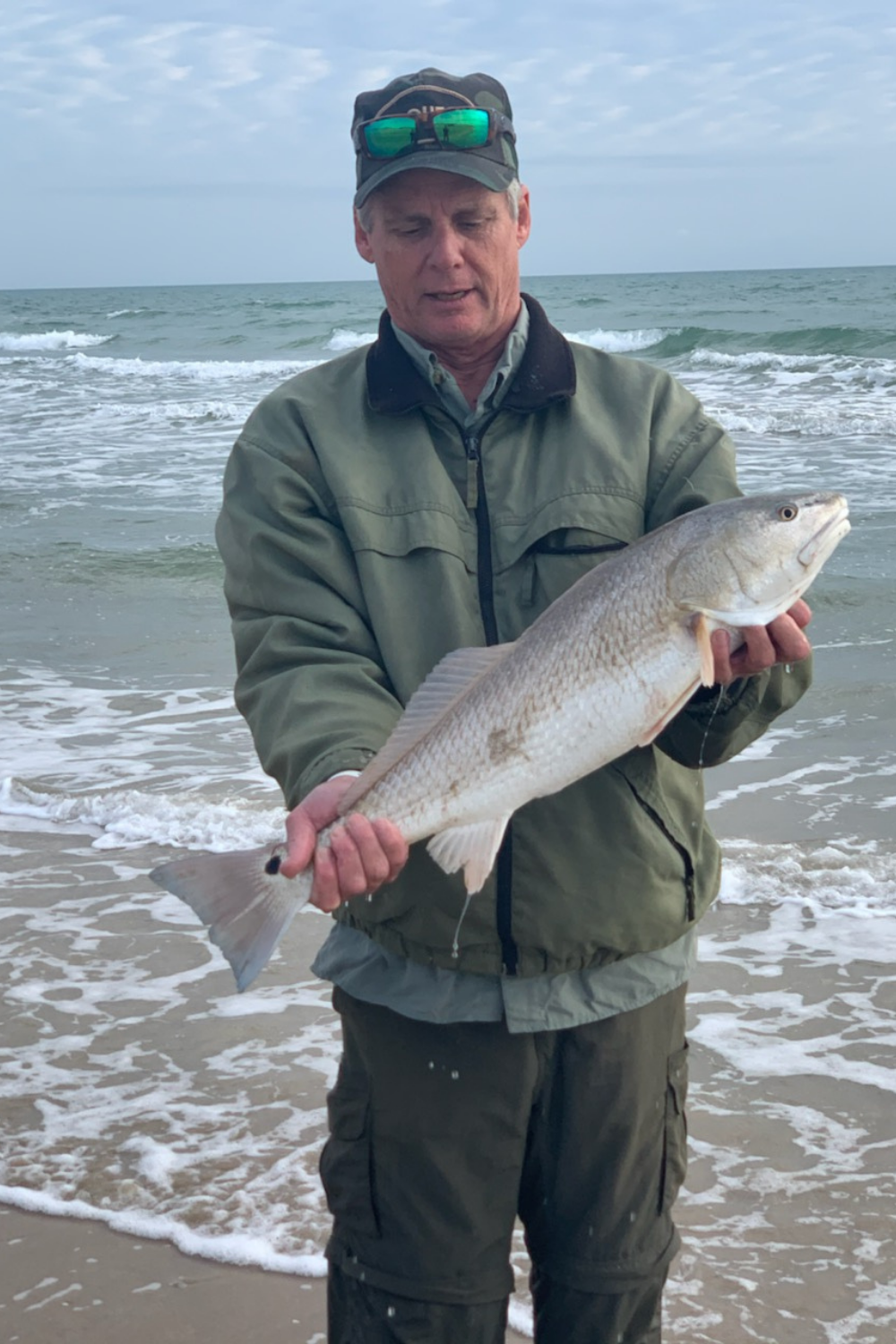
A life long surf fisherman with 50+ years of experience, I am also an avid hunter and outdoorsman. I will be sharing my passion for the outdoors with you so be prepared for hunting, fishing, camping, hiking and more. Along with gear reviews and the latest trends and innovations in the outdoor industry.
